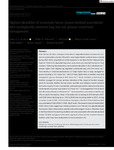Highest densities of mountain hares ( <i>Lepus timidus</i> ) associated with ecologically restored bog but not grouse moorland management
| dc.contributor.author | Bedson, CPE | |
| dc.contributor.author | Wheeler, PM | |
| dc.contributor.author | Reid, N | |
| dc.contributor.author | Harris, WE | |
| dc.contributor.author | Mallon, D | |
| dc.contributor.author | Caporn, S | |
| dc.contributor.author | Preziosi, Richard | |
| dc.date.accessioned | 2022-04-28T12:47:46Z | |
| dc.date.issued | 2022-04 | |
| dc.identifier.issn | 2045-7758 | |
| dc.identifier.issn | 2045-7758 | |
| dc.identifier.other | e8744 | |
| dc.identifier.uri | http://hdl.handle.net/10026.1/19110 | |
| dc.description.abstract |
<jats:title>Abstract</jats:title><jats:p>Over the last 20 years, ecological restoration of degraded habitats has become common in conservation practice. Mountain hares (<jats:italic>Lepus timidus scoticus</jats:italic>) were surveyed during 2017–2021 using 830 km of line transects in the Peak District National Park, England. Historically degraded bog areas were previously reported having low hare numbers. Following bog restoration, we found hare densities of 32.6 individuals km<jats:sup>−2</jats:sup>, notably higher than neighboring degraded (unrestored) bog with 24.4 hares km<jats:sup>−2</jats:sup>. Hare density on restored peatland was 2.7 times higher than on bogs managed for grouse shooting at 12.2 hares km<jats:sup>−2</jats:sup> and 3.3 times higher than on heather moorland managed for grouse shooting at 10.0 hares km<jats:sup>−2</jats:sup>. Yearly estimates varied most on habitats managed for grouse, perhaps indicative of the impact of habitat management, for example, heather burning and/or possible hare culling to control potential tick‐borne louping ill virus in gamebirds. Acid grassland used for sheep farming had a similar density to grouse moorland at 11.8 hares km<jats:sup>−2</jats:sup>. Unmanaged dwarf shrub heath had the lowest density at 4.8 hares km<jats:sup>−2</jats:sup>. Hare populations are characterized by significant yearly fluctuations, those in the study area increasing by 60% between 2017 and 2018 before declining by <jats:italic>ca</jats:italic>. 15% by 2020 and remaining stable to 2021. During an earlier survey in 2002, total abundance throughout the Peak District National Park was estimated at 3361 (95% CI: 2431–4612) hares. The present study estimated 3562 (2291–5624) hares suggesting a stable population over the last two decades despite fluctuations likely influenced by weather and anthropogenic factors. Mountain hares in the Peak District favored bog habitats and were associated with restored peatland habitat. Wildlife management should be cognizant of hare density variation between habitats, which may have implications for local extinction risk.</jats:p> | |
| dc.format.extent | e8744- | |
| dc.format.medium | Electronic-eCollection | |
| dc.language | en | |
| dc.language.iso | eng | |
| dc.publisher | Wiley Open Access | |
| dc.subject | blanket bog | |
| dc.subject | distance sampling | |
| dc.subject | grouse moor | |
| dc.subject | habitat degradation | |
| dc.subject | landscape restoration | |
| dc.subject | monitoring | |
| dc.subject | mountain hare | |
| dc.subject | peatland | |
| dc.title | Highest densities of mountain hares ( <i>Lepus timidus</i> ) associated with ecologically restored bog but not grouse moorland management | |
| dc.type | journal-article | |
| dc.type | Journal Article | |
| plymouth.author-url | https://www.webofscience.com/api/gateway?GWVersion=2&SrcApp=PARTNER_APP&SrcAuth=LinksAMR&KeyUT=WOS:000776835000001&DestLinkType=FullRecord&DestApp=ALL_WOS&UsrCustomerID=11bb513d99f797142bcfeffcc58ea008 | |
| plymouth.issue | 4 | |
| plymouth.volume | 12 | |
| plymouth.publication-status | Published | |
| plymouth.journal | Ecology and Evolution | |
| dc.identifier.doi | 10.1002/ece3.8744 | |
| plymouth.organisational-group | /Plymouth | |
| plymouth.organisational-group | /Plymouth/Faculty of Science and Engineering | |
| plymouth.organisational-group | /Plymouth/Faculty of Science and Engineering/School of Biological and Marine Sciences | |
| plymouth.organisational-group | /Plymouth/REF 2021 Researchers by UoA | |
| plymouth.organisational-group | /Plymouth/REF 2021 Researchers by UoA/UoA07 Earth Systems and Environmental Sciences | |
| plymouth.organisational-group | /Plymouth/Users by role | |
| plymouth.organisational-group | /Plymouth/Users by role/Academics | |
| dc.publisher.place | England | |
| dcterms.dateAccepted | 2022-02-24 | |
| dc.rights.embargodate | 2022-4-29 | |
| dc.identifier.eissn | 2045-7758 | |
| dc.rights.embargoperiod | Not known | |
| rioxxterms.versionofrecord | 10.1002/ece3.8744 | |
| rioxxterms.licenseref.uri | http://www.rioxx.net/licenses/all-rights-reserved | |
| rioxxterms.licenseref.startdate | 2022-04 | |
| rioxxterms.type | Journal Article/Review |


